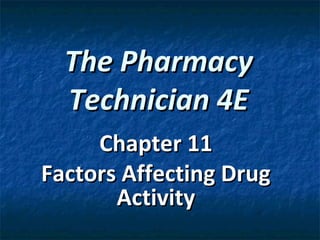
Chapter 11 human variability
- 1. The Pharmacy Technician 4E Chapter 11 Factors Affecting Drug Activity
- 2. Chapter Outline Human Variability Disease States Adverse Drug Reactions Drug-Drug Interactions Drug-Diet Interactions
- 3. Human Variability – Age Overall, metabolism declines with age. Neonates and infants Drug distribution, metabolism, and excretion slower. Children (age range from 1-12 yrs old.) Metabolize certain drugs more rapidly, e.g clindamycin, valproid acid, theophylline, ethosuximde and theophylline. The elderly Consume more drugs. Changes in gastric emptying, slow circulation, decline in liver and kidney functions.
- 4. Human Variability Gender Women and men handle drugs differently. Pregnancy Delayed gastric emptying. Genetics Determines type and amounts of proteins produced in the body.
- 5. Human Variability Pharmacognetics Defines the hereditary basis of individual differences in the ADME process. Body weight Important in dosing medication to children. Psychological factors Influences patients responses to drugs, e.g. placebo effect.
- 6. Diseases that affect drug disposition The disposition and effect of some drugs can be influenced by the presence of disease. Cirrhosis A chronic diseases that occurs with long term alcohol abuse. Acute viral hepatitis An inflammation condition of the liver caused by viruses. Obstructive jaundice Obstruction of the bile duct causing hepatic waste products and bile to accumulate in the liver.
- 7. Renal Diseases Reduced renal function can affect the elimination of many drugs. Nephro (of kidney): As renal function decreases, the dosage of a drug that is eliminated by the kidney should be reduced. Decrease in renal function is measured by the amount of creatinine in the blood.
- 8. Thyroid Disease Changes in thyroid function affects the disposition of many drugs. E.g. hypothyroidism (under active thyroid) increases the bioavailability of digoxin, riboflavin. E.g. hyperthyroidism (overactive thyroid) causes increased metabolism of theophylline, propranolol, propylthiouriacil, & methimazole.
- 9. Adverse Drug Reactions Drugs have a mixture of two effects . Therapeutic (desired) Adverse effects (undesired effects) Side effects Adverse Drug Event Harm caused by the drug. Adverse Drug Reaction Harm directly caused by the drug at normal doses. Medication Error Inappropriate use of a drug.
- 10. Common Adverse Drug Reactions Central Nervous System Effects CNS stimulation: agitation, confusion, disorientation. CNS Depression: dizziness, drowsiness, sedation, coma. Idiosyncrasy -Unexpected reaction to a drug. Hepatotoxicity Occurs with acetaminophen, isoniazide, nitrofurantoin. Nephrotoxicity Occurs with aminoglycosides, nonsteroidal anti- inflammatory drugs.
- 11. Hypersensitive or Allergy Any drug can produce an allergic reaction. Involves Antibodies antigen reaction Previous sensitization with a drug or a similar drug required. The reaction causes the release of histamine that leads to rash, itching, and in severe cases difficulty of breathing and even death. Anaphylactic shock - potentially fatal type of reaction and can occur within minutes.
- 12. Common Adverse Drug Reactions Gastrointestinal effects Teratogenicity Occur with nonsteroidal Substance causing anti-inflammatory drugs abnormal fetal (aspirin). development. Drug dependence Hematological effect Causes withdrawal effect Blood coagulation, upon discontinuation. bleeding, and bone Results from chronic use marrow disorder. of narcotic analgesics. Carcinogenicity Cancer causing drugs.
- 13. Drug-Drug Interactions Definition - Administration of more than one drug at a time. Results in an increase or decrease of the therapeutic effects. Time of reaction varies. Enzymes involved in the metabolism of drugs primarily occur in the liver.
- 14. Drug-Drug Interactions Additive Effects Occurs when two drugs result in an effect equal to the sum of the individual effects. E.g. trimethoprim + sufamethoxazle (Bactrim) for antibiotic effect. Potentiation Occurs when one drug with no inherent activity of its own increases the activity of another drug that produces an effect. E.g. carbidopa + dopa = prolonged action and longer duration of action for Parkinson's disease.
- 15. Drug-Drug Interactions Synergism Occurs when two drugs with similar pharmacological actions produce greater effects than the sum of individual effects. E.g. Acetaminophen + codeine (Tylenol #3®) caused increased analgesia. E.g. penicillin + gentamicin = increased antibacterial effects.
- 16. Drug-Drug Interactions Antidote A particular drug given to block or reduce the toxic effect of another drug. E.g. Vitamin K reverses the effect of warfarin (blood thinner medicine). E.g. Naloxone + morphine reverses the effect of morphine or other narcotics. Chelating Drug binds with another drug forming a complex which reduces absorption E.g. Aluminum or magnesium hydroxide (antacid) + tetracycline inhibits the antibiotic effect of TTC. E.g. Cholestyramine + thyroxine binding of thyroxin reducing its absorption.
- 17. Drug-Drug Interactions Displacement One drug from a protein binding site is replaced by another drug. E.g. aspirin + warfarin = increased effect of warfarin. Inhibition One drug inhibits the breakdown of another agent E.g. Cimetidine inhibit the breakdown of digoxin causing digoxin toxicity. Induction One drug increases an enzyme. Pharmacogenetics ffect of a gene on drug disposition.
- 18. Drug-Drug Interaction Induction: One drug increases the metabolizing enzyme that breaks down another drug. E.g. Phenytoin + oral contraceptives = decreased contraception effect. Urinary excretion: Drugs altering the urinary pH that cause a decrease in renal reabsorption. E.g. Sodium bicarbonate + Phenobarbital = increased excretion of Phenobarbital. E.g. Quinidine + digoxin = digoxin excretion is reduced by 30-50%.
- 19. Drug-Diet Interaction When elements of ingested nutrients interact with a drug affecting the disposition of the drug. Absorption TTC + Iron = decreases TTC absorption. Phenytoin + food = increased absorption. Interactions that alter absorption with food or nutrient can be avoided by separating the administration of drugs and food intake by about 2 hours. Specific food E.g. Cruciferous vegetables like cabbage and brussels sprouts may stimulate the metabolism of some drugs. E.g. Spinach and other green vegetables contain vitamin K and inhibit the action of warfarin. E.g. Tyramine containing food + monoamine oxidase (MAO) inhibitors = severe hypertension or intracranial hemorrhage.
- 20. Terms to Remember 1. Acute viral hepatitis 11. Enzyme induction 2. Additive effects 12. Enzyme inhibition 3. Adverse drug reaction 13. Hypersensitivity 4. Anaphylactic shock 14. Hyperthyroidism 5. Antidote 15. Hypothyroidism 6. Carcinogenicity 16. Idiosyncrasy 7. Cirrhosis 17. Obstructive jaundice 8. Complexation 18. Pharmacogenetics 9. Displacement 19. Potentiation 10. Drug–diet interactions 20. Synergism
